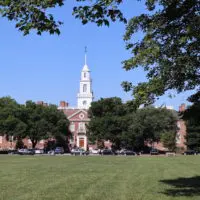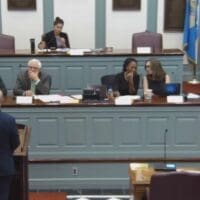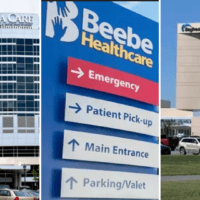

Appoquinimink system, parents are wrestling with proposed changes to allow elementary, middle and high schools to start at different times.
As the Appoquininimink School District considers trying to solve its busing issues by opening schools at three different times each day rather than the current two, it’s facing a series of Catch-22 dilemmas.
Each version of what-opens-when triggers a problem for a different age group.
Opening high schools last around 9 a.m. — an idea with a lot of biological research support — interferes with afternoon sports training and schedules, as well as after-school jobs that many students hold.
Opening elementary schools last means the youngest of the children may have to stay home without parents who will have gone to work and will need to make their way to bus stops on their own.
Opening middle schools last means there may be no older children at home to meet and tend to elementary students whose buses will have already dropped them off.
The district’s problems are rooted in a nationwide shortage of bus drivers, made worse by the COVID-19 pandemic and the “Great Resignation.”
In addition, Appo officials say, the system doesn’t have as much money as northern New Castle districts. More of the drivers there actually live in the districts they serve. Appo is also a bigger district than many others geographically and is composed largely of farmlands, so drivers must drive farther than their peers.
Superintendent Matt Burrows said during a Jan. 26 school board work session that the district traditionally had relied on retired people as bus drivers and many are afraid to come back to work or pick up work as a driver because of COVID-19.
“Our hope is that gets better once we get on the other side of COVID,” he said, “but we can’t guarantee that so early in the summer.”
The system already has offered an additional $4,200 for drivers that come on board.
“We have had some success with that,” Burrows said. “But as you’ve seen in previous presentations, we get nine drivers, we lose nine drivers just to the natural attrition of what happens.”
As of now, nearly 4,000 of Appo’s 12,000 students don’t have buses to take them to school, so families must fill that role. That creates traffic jams at schools that were not designed for mass drop-offs and pickups.
Under the current two-bell schedule, 18 of the district’s bus routes must get some kids to school an hour or two before classes start so the buses can head out for another round of students. At the end of the day, some students also have to stay up to two hours later so the bus drivers can make enough trips to get all the kids home.
Complicating the decision about whether to have schools start at two times or three is the continued rise in the number of students.
Appo’s enrollment has risen by more than 600 students this year, and it’s expected to rise another 500 in the next school year, Burrows said.
Also complicating the decision is the size of the district, which is more sprawling than state school districts. Buses need at least 50 minutes between dropping off one load and being able to get another load back to a school. The system tried to drop that to just 45 minutes and it would not work.
The decision about what to do will come back to the table for the School Board when it meets tonight, Feb. 8, at 7 p.m. The three-tier system is on the agenda for a second read.
Normally, the board would take a vote immediately after a proposal has been read the second time. But board members in the Jan. 26 workshop seemed inclined to continue to search for other options.
Some of those may come from the district’s transportation committee, which has been exploring options including the system buying its own buses rather than contracting, and other ways to make driving in Appo attractive.
That could include allowing drivers to choice their own children into Appo schools or even allowing them to bring their own children aboard the bus in the morning during runs. The committee will meet again on Feb. 22 and March 22.
The state is also offering a carrot for new drivers: It’s expected to propose a pay hike for bus drivers in the Fiscal Year 2023 budget, which takes effect July 1.
Under Appo’s current two-tier school opening times, middle and high schools start at 8 a.m. and end at 2:40 p.m., with pre-K and elementary schools starting at 9 a.m. and going until 3:40 p.m.
The version of the three-tier program that was released for discussion and public input would have had elementary schools start at 7:40 a.m. and end at 2:20 p.m.;pre-K start at 8:30 a.m. and end at 2:30 p.m.; high schools start at 8:30 a.m. and end at 3:10 p.m.; and middle schools start at 9:30 a.m. and end at 4 p.m.
After receiving 790 email comments and hearing from several parents in the audience Jan. 26, the board asked Burrows to redraw the suggested times with middle school starting early and elementary last.
One of the sticking points in the system is that according to state guidelines, buses can hold 72 elementary students, but only 48 high school students, so combining the students in one bus is not efficient, said Thomas Poehlmann, director of safety, security and operations, during the Jan. 26 meeting.
While the materials sent to parents focus on school start times, Poehlmann said in a later interview that the pickup times for kids are likely to be much earlier. For example, he said, an elementary student whose school started at 9 a.m. would likely be picked up from 8 a.m. to 8:20 a.m.
Any way the schedule is arranged, he agreed, “It’s definitely a stressor for a lot of families.”
The system exists to educate children, he said, and it’s got to find a way to get them into schools.
Ultimately, Poehlmann said, “There’s got to be compromise. I’m a strong advocate for what we proposed, a strong advocate, but I also can tell you, no matter what way you would flip those times, I can find some benefit for kids in those times.”
The system had planned to offer after-care at elementary and pre-K schools from 2:20 p.m. to 3:20 p.m. Those programs would have been overseen by staff members with the help of the Teacher Academy Pathway students who plan to go into education.
When one audience member asked why the district is continuing to build more schools instead of investing in buses, Burrows told him that the money comes from different pots and can’t just be swapped from one to another.
Currently, Appo contracts with bus services once the state tells it how many routes it will pay for. Transportation companies can accept or refuse a route.
Charter schools are not funded the same, Burrows pointed out. They get a pot of money and can use it as they like.
Appoquinimink won’t be alone in moving to a three-tier system, Burrows said in the Jan. 26 meeting. Many other systems already have a three-tier school opening system.
“We’ve been very fortunate as a community that we’ve been able to stay on a two-tier system as we’ve grown,” Burrows said. “We’re the third-largest district in the state, the third-largest in the county, getting ready to be the second. So we’ve been very fortunate that we haven’t had to do three here.
“We’re in a situation now where I don’t see any other options. And again, I’m gonna reiterate I’m not saying this is the most convenient, by no means am I saying that. But it’s something has to be done to meet the needs of those 4,500 students that we currently are not meeting.”


Betsy Price is a Wilmington freelance writer who has 40 years of experience.
Share this Post









